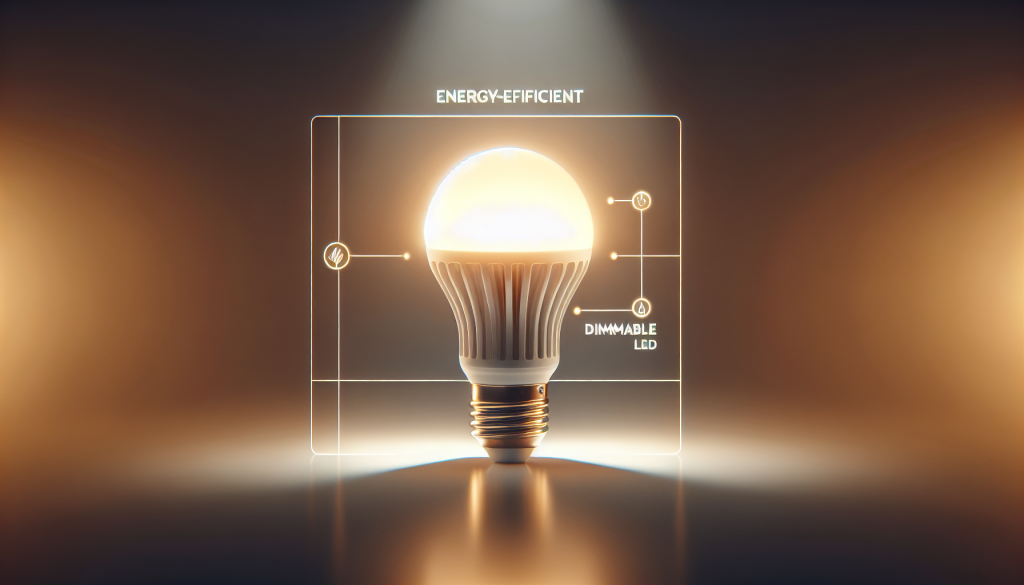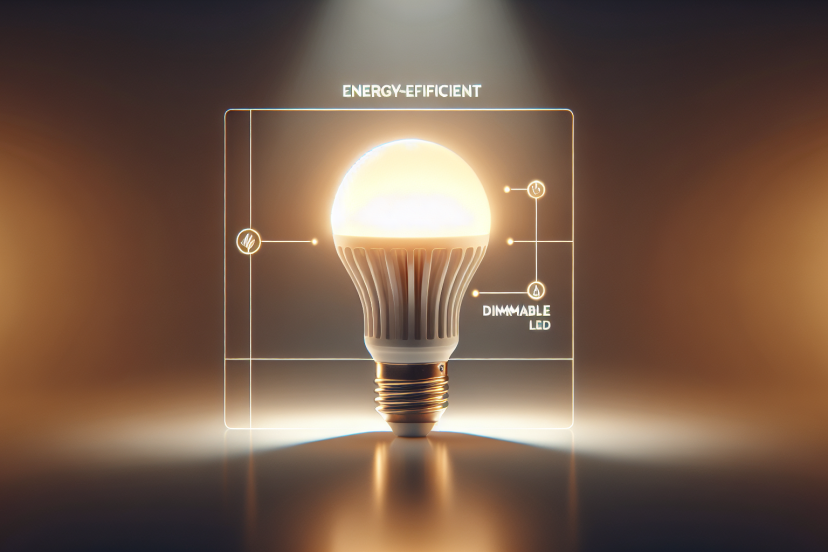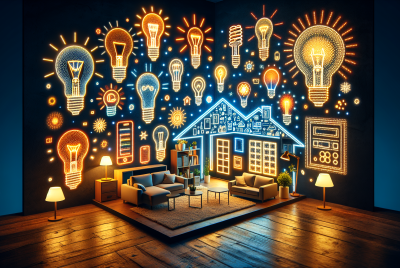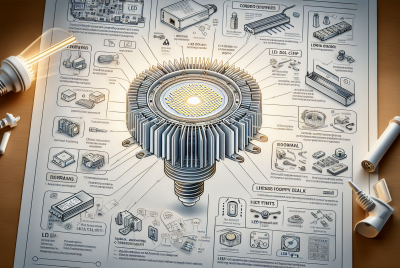The Ultimate Guide To Dimmable LED Lighting
Are you tired of harsh and glaring lights that leave you squinting and uncomfortable? Look no further! “The Ultimate Guide To dimmable LED lighting” is here to save the day. This comprehensive guide will walk you through everything you need to know about dimmable LED lighting, from how it works to its benefits and tips for choosing the perfect dimmable LED lights for your home or workspace. Say goodbye to the days of one-size-fits-all lighting and hello to a world of customizable ambiance and energy efficiency. Get ready to transform your space into a haven of soft, warm, and inviting light.
Understanding Dimmable LED Lighting
What is dimmable LED lighting?
Dimmable LED lighting refers to LED lights that can be adjusted to emit varying levels of brightness. Unlike traditional light bulbs, which only have two settings (on and off), dimmable LED lights offer a range of brightness options. This feature allows you to customize the lighting in a room to suit your needs and preferences, whether you want bright, intense lighting or a soft, cozy ambiance.
How does dimmable LED lighting work?
Dimmable LED lighting utilizes advanced electronic technology to control the amount of current flowing through the LED chips. This control is achieved through a dimmer switch or a compatible lighting control system. By adjusting the amount of electric current supplied to the LED chips, the brightness of the light emitted can be varied. This technology allows for smooth and seamless dimming, without any flickering or buzzing, ensuring a comfortable lighting experience.
Advantages of dimmable LED lighting
Dimmable LED lighting offers several advantages over traditional lighting options. First and foremost, it provides energy efficiency, as the brightness of the LED can be adjusted to match the required lighting level, thereby saving electricity and reducing energy costs. Additionally, the ability to dim the lights allows for creating different moods and ambiance in any setting, be it your home or a commercial space. Furthermore, dimmable LED lights have an extended lifespan compared to traditional bulbs, reducing the frequency of replacements and maintenance.
Choosing the Right Dimmable LED Bulb
Types of dimmable LED bulbs
There are various types of dimmable LED bulbs available in the market to suit different lighting requirements. Some common options include A-type bulbs (similar in shape to traditional incandescent bulbs), BR bulbs (bulged reflector) for directional lighting, and MR bulbs (multifaceted reflector) commonly used for accent lighting. Additionally, there are also LED strips and panels that can be dimmed to create unique lighting effects. It is important to choose the right type of dimmable LED bulb based on the desired lighting effect and the specific application.
Factors to consider when choosing dimmable LED bulbs
When selecting dimmable LED bulbs, it is essential to consider several factors to ensure optimal performance and compatibility. The first factor to consider is the dimmer switch compatibility. Not all dimmer switches are compatible with dimmable LED bulbs, so it is necessary to choose bulbs that are compatible with the dimmer switch in your space. Additionally, it is important to consider the color temperature and the color rendering index (CRI) of the LED bulbs to achieve the desired lighting quality. Lastly, it is crucial to choose dimmable LED bulbs from reputable manufacturers to ensure high-quality and reliable performance.

Installing Dimmable LED Lighting
Compatible dimmer switches
To install dimmable LED lighting, it is important to ensure that the dimmer switch being used is compatible with LED bulbs. Not all traditional dimmer switches are suitable for use with LEDs, as they may not provide the necessary low-level current required for stable dimming. Therefore, it is recommended to use a dimmer switch specifically designed for LED lighting. These switches have built-in features to control the electric current flow to the LEDs and provide smooth and efficient dimming functionality.
Installation process of dimmable LED lights
Installing dimmable LED lights follows a standard process similar to that of installing non-dimmable LED lights. Firstly, you need to turn off the power supply to the lighting circuit. Then, remove the existing light fixture or bulb and replace it with the dimmable LED fixture or bulb. Make sure to follow the manufacturer’s instructions for wiring and installation. Once the new LED lights are securely installed, you can proceed with connecting the dimmer switch. Ensure all connections are properly made and test the dimming functionality before restoring power to the circuit.
Dimmer Switches for LED Lighting
Types of dimmer switches
There are several types of dimmer switches available for use with LED lighting. The most common types include rotary, slide, and touch dimmer switches. Rotary dimmer switches feature a rotating knob to adjust the brightness level. Slide dimmer switches have a sliding lever that moves horizontally to control the brightness. Touch dimmer switches, on the other hand, have a touch-sensitive surface that allows for easy and precise dimming control with a simple touch. Each type of dimmer switch offers different user experiences and can be chosen based on personal preference and the desired aesthetics.
Compatibility of LED lights with dimmer switches
Not all LED lights are compatible with dimmer switches. It is crucial to choose LED lights that are specifically labeled as dimmable. These LED lights are designed with special drivers that enable smooth and efficient dimming. Using non-dimmable LED lights with a dimmer switch can result in flickering, buzzing, or even damage to the lights. Therefore, it is important to ensure compatibility between the LED lights and the dimmer switch to guarantee optimal performance and avoid any electrical issues.

Dimming Techniques for LED Lighting
Phase-cut dimming
Phase-cut dimming, also known as triac dimming, is one of the most common dimming techniques used for LED lighting. It works by cutting off a portion of the input current waveform, which reduces the power supplied to the LED bulb and results in lower light output. Phase-cut dimming is efficient and cost-effective, making it widely used in residential and commercial applications. However, it may cause compatibility issues with certain LED bulbs, so it is essential to choose dimmable LED bulbs that are compatible with phase-cut dimmers.
Pulse-width modulation (PWM) dimming
Pulse-width modulation (PWM) dimming is another popular technique used for dimming LEDs. It involves rapidly cycling the LED on and off at a high frequency. By varying the width of the on-time versus the off-time, the average current flowing through the LED can be adjusted, resulting in dimming. PWM dimming offers precise control over the dimming levels and is commonly used in applications that require flicker-free and smooth dimming, such as home theaters and photography lighting setups.
Digital addressable lighting interface (DALI) dimming
Digital addressable lighting interface (DALI) dimming is a digital control protocol specifically designed for lighting systems. It allows for individual control and dimming of each LED light in a DALI network. DALI dimming offers advanced functionality, such as monitoring the status of each light and creating complex lighting scenes. This technique is commonly used in commercial and architectural lighting installations, where precise control and flexibility are required.
Troubleshooting Dimmable LED Lighting
Issues with flickering or buzzing LED lights
Flickering or buzzing of dimmable LED lights is a common issue that can be caused by various factors. One of the main reasons for flickering or buzzing is using incompatible dimmer switches or incompatible LED bulbs. It is important to ensure that the dimmer switch and LED bulbs are compatible and designed for each other. Other factors that can contribute to flickering or buzzing include poor wiring connections, voltage fluctuations, or electromagnetic interference. To troubleshoot these issues, check the compatibility between the dimmer switch and LED bulbs and ensure all connections are secure.
Understanding compatibility problems
Compatibility problems between dimmer switches and LED bulbs can arise due to various factors. Some dimmer switches are designed for specific types of bulbs, such as incandescent or halogen, and may not be compatible with LEDs. Additionally, dimmer switches have minimum and maximum load requirements, which should be considered when selecting LED bulbs. If the load is below the minimum requirements, the dimming function may not work properly, and if it exceeds the maximum requirements, it can lead to flickering or buzzing. Carefully reading the manufacturer’s specifications and ensuring compatibility is essential to avoid compatibility problems.
Solutions to common dimming issues
There are several solutions to common dimming issues with LED lights. If you are experiencing flickering or buzzing, try replacing the dimmer switch with one that is specifically designed for LED bulbs. Additionally, consider choosing LED bulbs that are labeled as compatible with dimmers and have been tested for smooth dimming. In cases where poor wiring connections are causing problems, it is important to ensure all connections are secure and properly insulated. If voltage fluctuations are the cause of dimming issues, consult with an electrician to stabilize the voltage in your electrical system.
Benefits of Dimmable LED Lighting
Energy efficiency
One of the significant benefits of dimmable LED lighting is its energy efficiency. By adjusting the brightness level of the LED lights according to the required lighting needs, you can significantly reduce energy consumption compared to non-dimmable lighting options. Dimmable LED lights consume less energy when operated at lower light levels, resulting in lower electricity bills and a reduced carbon footprint.
Enhanced ambiance and mood
Dimmable LED lighting provides the ability to create different ambiance and moods in any space. Whether you want bright, vibrant lighting for a lively atmosphere or soft, warm lighting for a cozy and relaxing ambiance, dimmable LED lights can cater to your preferences. Adjusting the brightness level allows for customization of the lighting to suit various activities and occasions, such as cozy movie nights, romantic dinners, or productive work environments.
Extended lifespan of LED bulbs
Another advantage of dimmable LED lighting is the extended lifespan of LED bulbs. By operating the LED lights at lower brightness levels, you reduce the stress on the LED chips and increase their overall lifespan. Dimmable LED bulbs typically have a longer lifespan compared to traditional incandescent bulbs, reducing the frequency of bulb replacements and maintenance. This not only saves costs but also reduces waste and the environmental impact associated with frequent bulb replacements.
Applications of Dimmable LED Lighting
Residential use
Dimmable LED lighting is widely used in residential settings to enhance the aesthetics and make living spaces more functional. In living rooms, dimmable LED lights allow for creating different atmospheres for relaxation, gatherings, or parties. In bedrooms, they offer the ability to adjust the lighting for reading or provide a soothing ambience for sleep. Dimmable LED lights in kitchens can provide bright illumination for cooking tasks or a cozy atmosphere for dining. Additionally, they can be used in outdoor spaces, such as gardens or patios, to create a pleasant and inviting environment.
Commercial use
In commercial spaces, dimmable LED lighting offers versatility and control over the lighting environment. Retail stores can use dimmable LED lights to highlight specific products or create different moods in different sections of the store. Restaurants and cafes can adjust the lighting levels to create a cozy and intimate atmosphere for dining. Offices can utilize dimmable LED lights to provide optimal task lighting and adjust the brightness for employee comfort and productivity. Moreover, hotels, museums, art galleries, and theaters can benefit from dimmable LED lighting to create specific lighting scenes and enhance the overall experience for visitors.
Specialized applications
Dimmable LED lighting also finds its applications in various specialized settings. In healthcare facilities, such as hospitals or clinics, dimmable LED lights can be adjusted to provide the appropriate lighting levels for examinations, surgeries, or patient rooms. In educational institutions, dimmable LED lights can be used to create ideal lighting conditions in classrooms, study areas, or auditoriums. Outdoor lighting systems like streetlights or parking lot lights can be dimmed during low-traffic periods to conserve energy. The versatility and adaptability of dimmable LED lighting make it suitable for a wide range of specialized applications.
Maintenance and Care of Dimmable LED Lights
Cleaning and dusting
Proper maintenance and care are important for keeping dimmable LED lights in optimal condition. Regular cleaning and dusting of the light fixtures and bulbs help remove dirt and debris that can accumulate over time and affect the performance of the lights. For cleaning, it is recommended to use a soft microfiber cloth or a mild soap solution. Avoid using abrasive materials or harsh chemicals that can scratch or damage the LED lights. Cleaning should be done when the lights are turned off and cooled down to prevent the risk of electric shock.
Replacing and disposing of bulbs
While the lifespan of dimmable LED bulbs is significantly longer compared to traditional incandescent bulbs, eventually, they will need replacing. When it comes to replacing dimmable LED bulbs, it is important to choose bulbs that are compatible with the dimmer switch and the specific lighting fixture. Follow the manufacturer’s instructions for safe and proper installation. When disposing of old LED bulbs, check the local regulations regarding the disposal of electronic waste. Many communities have recycling programs in place for LED bulbs to ensure their proper disposal.
Future Trends in Dimmable LED Lighting
Advancements in dimming technology
The future of dimmable LED lighting holds exciting advancements in dimming technology. LED lighting manufacturers are constantly innovating and developing new dimming techniques and technologies to improve the overall user experience. These advancements may include more precise and efficient dimming algorithms, wireless control options, and integrated sensors for automatic dimming based on occupancy or ambient light levels. Additionally, advancements in smart home technology will likely lead to increased integration and automation of dimmable LED lighting systems.
Integration with smart home systems
As smart home systems become increasingly popular, the integration of dimmable LED lighting with these systems is becoming a prominent trend. Dimmable LED lights can be connected to smart home hubs or controlled through voice commands, mobile apps, or home automation systems. This integration allows for easy and convenient control over the lighting in your home, with options for scheduling, remote control, and even synchronization with other smart devices. The future of dimmable LED lighting will likely see a seamless integration with smart home systems, providing enhanced functionality and user experience.




